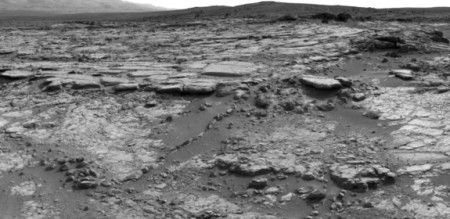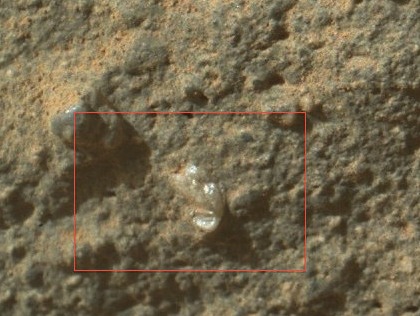
The sinuous rock feature in the lower center of this mosaic of images recorded by the NASA Mars rover Curiosity is called “Snake River.” Image taken Dec. 20, 2012.
CREDIT: NASA/JPL-Caltech
New analysis of a Martian meteor that found its way to earth shows a great deal of water in the planet’s crust. Meanwhile,NASA released this sharply detailed panorama above of Curiosity’s surroundings. And a reader offered this great point for consideration on the feature called the Flower,
“You know what it looks like to me? A clean, broken face of a phenocryst. It looks similar in size and shape to the other larger grains in that picture but, well, clean. I wonder if it’s possible the instrument or some part of the rover whacked that spot and broke off the tip so now we’re just seeing the unweathered part of the mineral.
I’ve magnified the image and processed it for clarity above. Looking closely the small impact hypothesis seems even more plausible to me for several reasons. The first is circumstantial, we don’t see these kinds of features all over and the odds of Curiosity landing right next to a super rare item on the surface of Mars is low. In addition the flower is very small, the scales aren’t too clear, but some surfing around suggests it’s just a few millimeters across.
Next is opportunity: there indeed would have been some debris coming down in that same region, in fact we’ve already seen some of it lying around. On top of that there was a strong downdraft of retrorockets in the last stage of descent almost right above the Flower which could have included small, high velocity particulates.And there are clearly less conspicuous features which look like they could also harbor translucent crystals if they were chipped.
But what really caught my attention is the feature on the top left corner of the red square: it looks like another crystal that took a glancing blow by whatever might have cleaned or chipped the Flower itself. Eureka!
Well even if that hypothesis turns out to be wrong, this shows that online crowd sourcing is a potentially powerful tool. I say potentially because it would be real easy for less disciplined readers to egg one another on and create all kinds of fanciful explanations. It could even lead to a sort of online mass hysteria. But in a community of thoughtful, pragmatic Freethinkers, many heads can definitely be better than one.


To me, the luster is suggestive of gypsum. Shallow evaporation basins can produce the gypsum or barite “desert roses” that are fairly common in arid regions.
A crystal structure revealed after an outer crust sounds right. But the cause of the removal of crust wouldn’t be a casual impact with wheel or manipulator arm. That, IMHO, would leave remains of the crust very close to the crystal. And I’m not seeing any loose pieces or particles that might be the remains of any crust.
It doesn’t rule out landing rockets. They, I assume, would produce enough wind to blow away any bits of crust that might have broken off.
Which leaves the landing rockets as the most likely cause because I’m having a hard time imagining any other outside force strong enough to both break the crust and blow away any particles broken off.
A couple of things I would like to clarify. First, a phenocryst is a large crystal in an igneous matrix and the surroundings of the “flower” do not appear to be the type of igneous rock that would have phenocrysts. Secondly, Curiostiy landed some several hundreds of meters away from where this picture was taken and it is unlikely that nozzle blast from the descent engines would have had an effect here.
My guess is that that this is a crystalline mineral deposit (probably sedimentary) that has been exposed by some several billion years of Martian wind erosion.